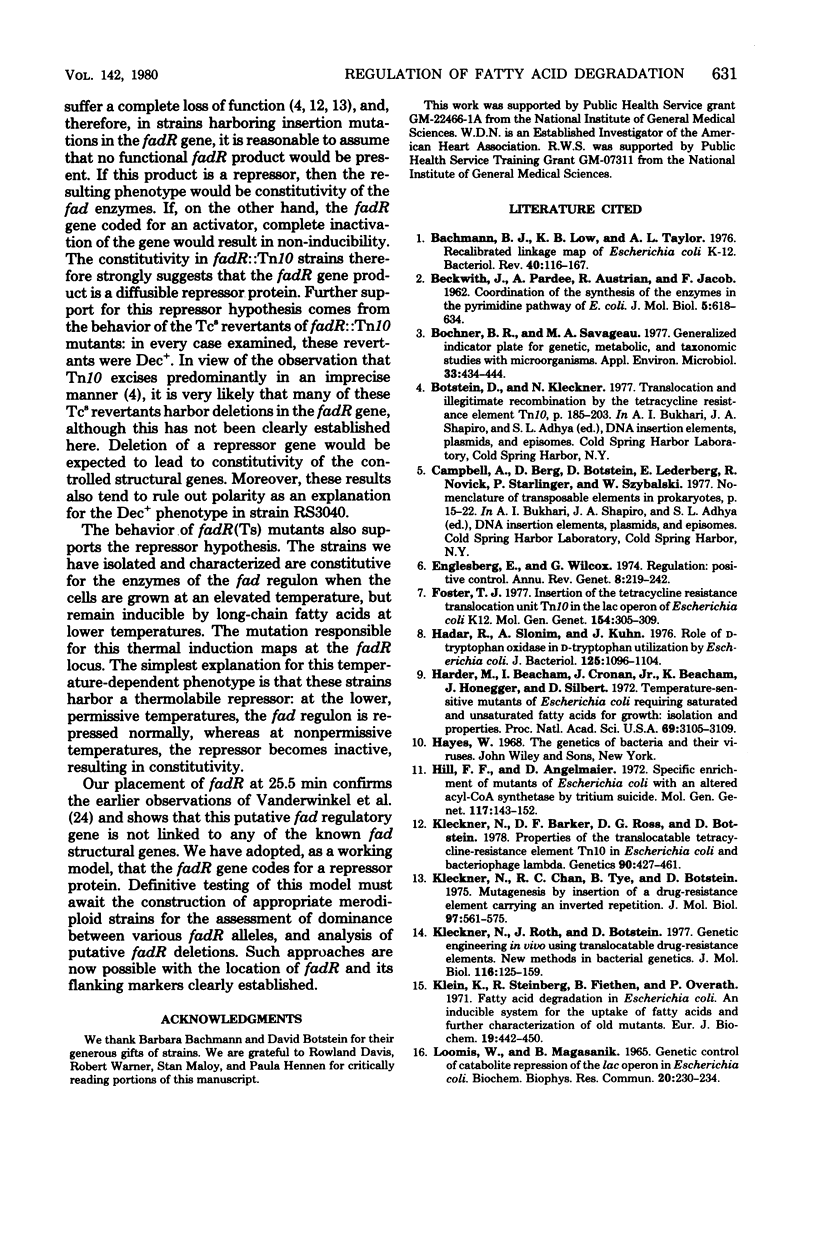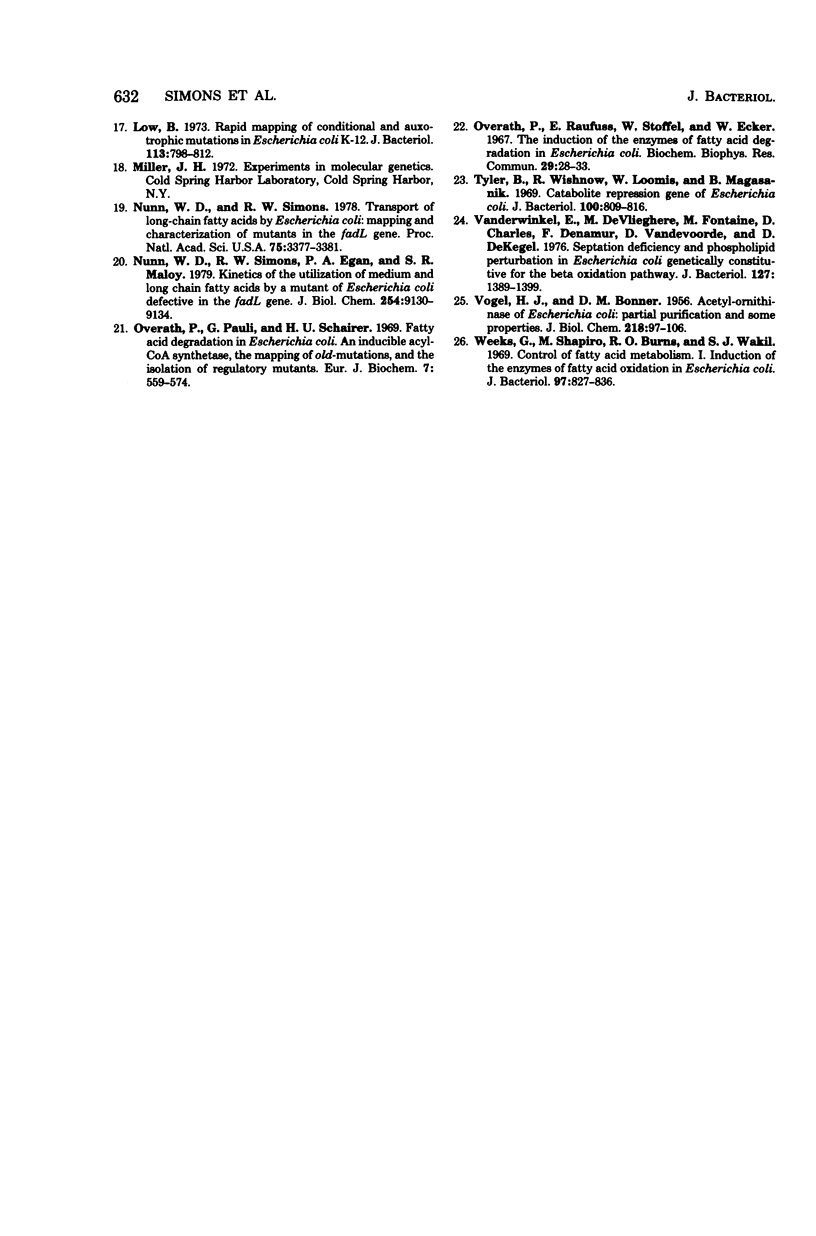Abstract
Transposon Tn10 was used to mutagenize the fadR gene in Escherichia coli. Mutants bearing fadR:Tn10 insertion mutations were found to (i) utilize the noninducing fatty acid decanoate as sole carbon source, (ii) beta-oxidize fatty acids at constitutive rates, and (iii) contain constitutive levels of the five key beta-oxidative enzymes. These characteristics were identical to those observed in spontaneous fadR mutants. The constitutive phenotype presented by the fadR:Tn10 mutants was shown to be genetically linked to the associated transposon-encoded drug resistance. These results suggest that the fadR gene product exerts negative control over the fatty acid degradative regulon. The fadR gene of E. coli has been mapped through the use of transposon-mediated fadR insertion mutations. The fadR locus is at 25.5 min on the revised map and cotransduces with purB, hemA, and trp. Three-factor conjugational and transductional crosses indicate that the order of loci in this region of the chromosome is purB-fadR-hemA-trp. Spontaneous fadR mutants were found to map at the same location. Strains that exhibit alterations in the control of the fad regulon in response to changes in temperature were also isolated and characterized. These fadR(Ts) mutants were constitutive for the fad enzymes at elevated temperatures and inducible for these activities at low temperatures. The fadR(Ts) mutations also map at the fadR locus. These results strongly suggest that the fadR gene product is a repressor protein.
Full text
PDF











Selected References
These references are in PubMed. This may not be the complete list of references from this article.
- BECKWITH J. R., PARDEE A. B., AUSTRIAN R., JACOB F. Coordination of the synthesis of the enzymes in the pyrimidine pathway of E. coli. J Mol Biol. 1962 Dec;5:618–634. doi: 10.1016/s0022-2836(62)80090-4. [DOI] [PubMed] [Google Scholar]
- Bachmann B. J., Low K. B., Taylor A. L. Recalibrated linkage map of Escherichia coli K-12. Bacteriol Rev. 1976 Mar;40(1):116–167. doi: 10.1128/br.40.1.116-167.1976. [DOI] [PMC free article] [PubMed] [Google Scholar]
- Bochner B. R., Savageau M. A. Generalized indicator plate for genetic, metabolic, and taxonomic studies with microorganisms. Appl Environ Microbiol. 1977 Feb;33(2):434–444. doi: 10.1128/aem.33.2.434-444.1977. [DOI] [PMC free article] [PubMed] [Google Scholar]
- Englesberg E., Wilcox G. Regulation: positive control. Annu Rev Genet. 1974;8:219–242. doi: 10.1146/annurev.ge.08.120174.001251. [DOI] [PubMed] [Google Scholar]
- Foster T. J. Insertion of the tetracycline resistance translocation unit Tn10 in the lac operon of Escherichia coli K12. Mol Gen Genet. 1977 Sep 9;154(3):305–309. doi: 10.1007/BF00571287. [DOI] [PubMed] [Google Scholar]
- Hadar R., Slonim A., Kuhn J. Role of D-tryptophan oxidase in D-tryptophan utilization by Escherichia coli. J Bacteriol. 1976 Mar;125(3):1096–1104. doi: 10.1128/jb.125.3.1096-1104.1976. [DOI] [PMC free article] [PubMed] [Google Scholar]
- Harder M. E., Beacham I. R., Cronan J. E., Jr, Beacham K., Honegger J. L., Silbert D. F. Temperature-sensitive mutants of Escherichia coli requiring saturated and unsaturated fatty acids for growth: isolation and properties. Proc Natl Acad Sci U S A. 1972 Nov;69(11):3105–3109. doi: 10.1073/pnas.69.11.3105. [DOI] [PMC free article] [PubMed] [Google Scholar]
- Hill F. F., Angelmaier D. Specific enrichment of mutants of Escherichia coli with an altered acyl CoA synthetase by tritium suicide. Mol Gen Genet. 1972;117(2):143–152. doi: 10.1007/BF00267611. [DOI] [PubMed] [Google Scholar]
- Kleckner N., Barker D. F., Ross D. G., Botstein D. Properties of the translocatable tetracycline-resistance element Tn10 in Escherichia coli and bacteriophage lambda. Genetics. 1978 Nov;90(3):427–461. doi: 10.1093/genetics/90.3.427. [DOI] [PMC free article] [PubMed] [Google Scholar]
- Kleckner N., Chan R. K., Tye B. K., Botstein D. Mutagenesis by insertion of a drug-resistance element carrying an inverted repetition. J Mol Biol. 1975 Oct 5;97(4):561–575. doi: 10.1016/s0022-2836(75)80059-3. [DOI] [PubMed] [Google Scholar]
- Kleckner N., Roth J., Botstein D. Genetic engineering in vivo using translocatable drug-resistance elements. New methods in bacterial genetics. J Mol Biol. 1977 Oct 15;116(1):125–159. doi: 10.1016/0022-2836(77)90123-1. [DOI] [PubMed] [Google Scholar]
- Klein K., Steinberg R., Fiethen B., Overath P. Fatty acid degradation in Escherichia coli. An inducible system for the uptake of fatty acids and further characterization of old mutants. Eur J Biochem. 1971 Apr;19(3):442–450. doi: 10.1111/j.1432-1033.1971.tb01334.x. [DOI] [PubMed] [Google Scholar]
- Loomis W. F., Jr, Magasanik B. Genetic control of catabolite repression of the lac operon in Escherichia coli. Biochem Biophys Res Commun. 1965 Jul 12;20(2):230–234. doi: 10.1016/0006-291x(65)90351-7. [DOI] [PubMed] [Google Scholar]
- Low B. Rapid mapping of conditional and auxotrophic mutations in Escherichia coli K-12. J Bacteriol. 1973 Feb;113(2):798–812. doi: 10.1128/jb.113.2.798-812.1973. [DOI] [PMC free article] [PubMed] [Google Scholar]
- Nunn W. D., Simons R. W., Egan P. A., Maloy S. R. Kinetics of the utilization of medium and long chain fatty acids by mutant of Escherichia coli defective in the fadL gene. J Biol Chem. 1979 Sep 25;254(18):9130–9134. [PubMed] [Google Scholar]
- Nunn W. D., Simons R. W. Transport of long-chain fatty acids by Escherichia coli: mapping and characterization of mutants in the fadL gene. Proc Natl Acad Sci U S A. 1978 Jul;75(7):3377–3381. doi: 10.1073/pnas.75.7.3377. [DOI] [PMC free article] [PubMed] [Google Scholar]
- Overath P., Pauli G., Schairer H. U. Fatty acid degradation in Escherichia coli. An inducible acyl-CoA synthetase, the mapping of old-mutations, and the isolation of regulatory mutants. Eur J Biochem. 1969 Feb;7(4):559–574. [PubMed] [Google Scholar]
- Overath P., Raufuss E. M. The induction of the enzymes of fatty acid degradation in Escherichia coli. Biochem Biophys Res Commun. 1967 Oct 11;29(1):28–33. doi: 10.1016/0006-291x(67)90535-9. [DOI] [PubMed] [Google Scholar]
- Tyler B., Wishnow R., Loomis W. F., Jr, Magasanik B. Catabolite repression gene of Escherichia coli. J Bacteriol. 1969 Nov;100(2):809–816. doi: 10.1128/jb.100.2.809-816.1969. [DOI] [PMC free article] [PubMed] [Google Scholar]
- VOGEL H. J., BONNER D. M. Acetylornithinase of Escherichia coli: partial purification and some properties. J Biol Chem. 1956 Jan;218(1):97–106. [PubMed] [Google Scholar]
- Vanderwinkel E., De Vlieghere M., Fontaine M., Charles D., Denamur F., Vandevoorde D., De Kegel D. Septation deficiency and phosphilipid perturbation in Escherichia coli genetically constitutive for the beta oxidation pathway. J Bacteriol. 1976 Sep;127(3):1389–1399. doi: 10.1128/jb.127.3.1389-1399.1976. [DOI] [PMC free article] [PubMed] [Google Scholar]
- Weeks G., Shapiro M., Burns R. O., Wakil S. J. Control of fatty acid metabolism. I. Induction of the enzymes of fatty acid oxidation in Escherichia coli. J Bacteriol. 1969 Feb;97(2):827–836. doi: 10.1128/jb.97.2.827-836.1969. [DOI] [PMC free article] [PubMed] [Google Scholar]


